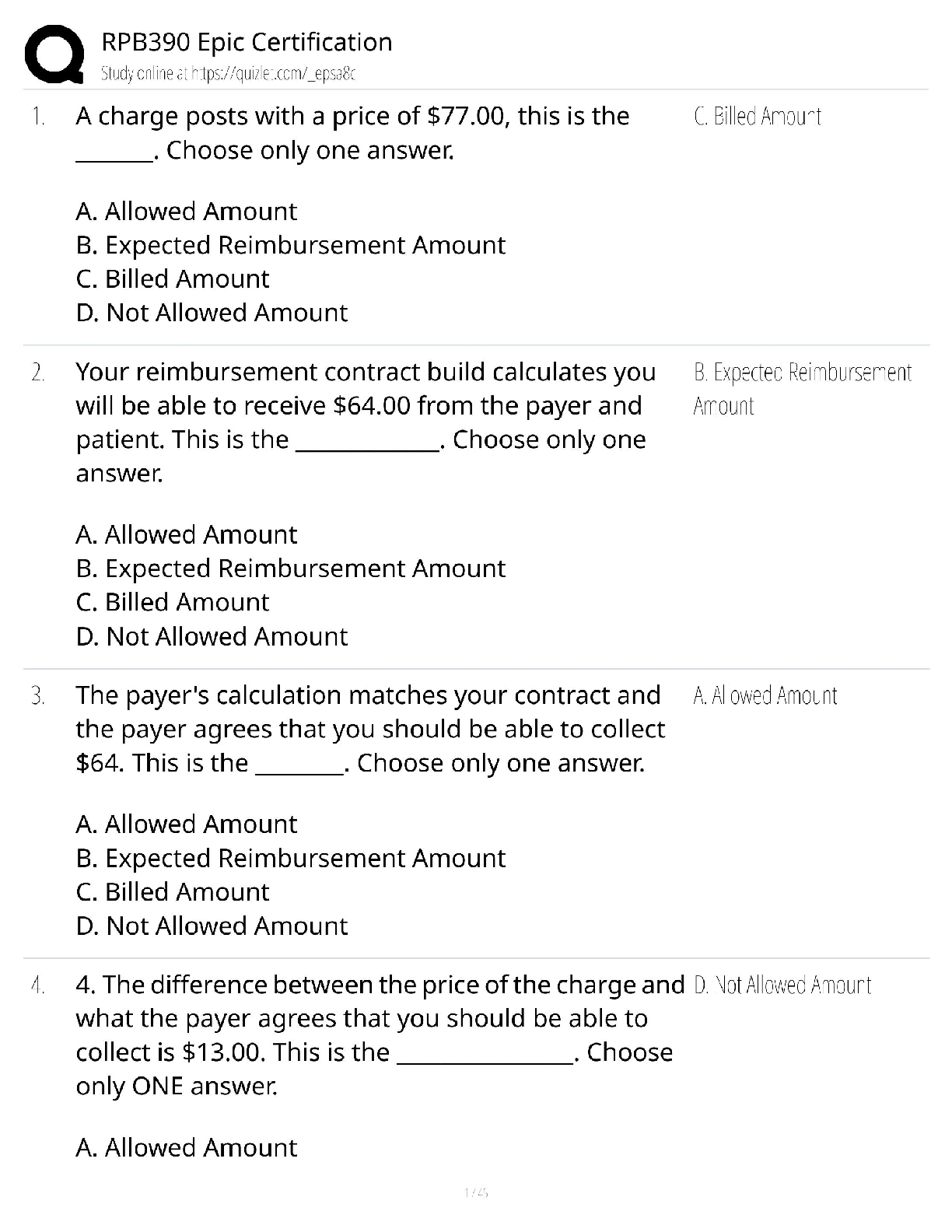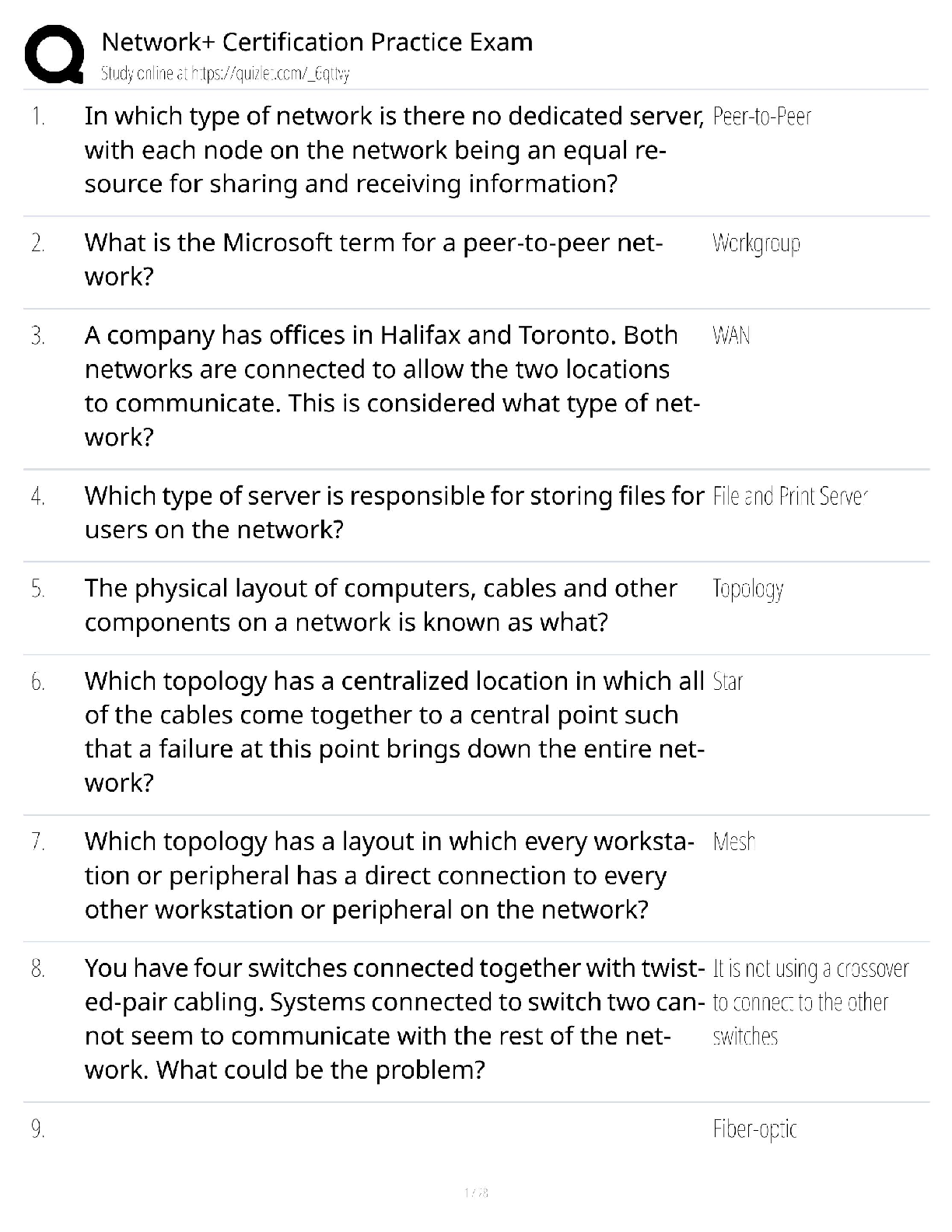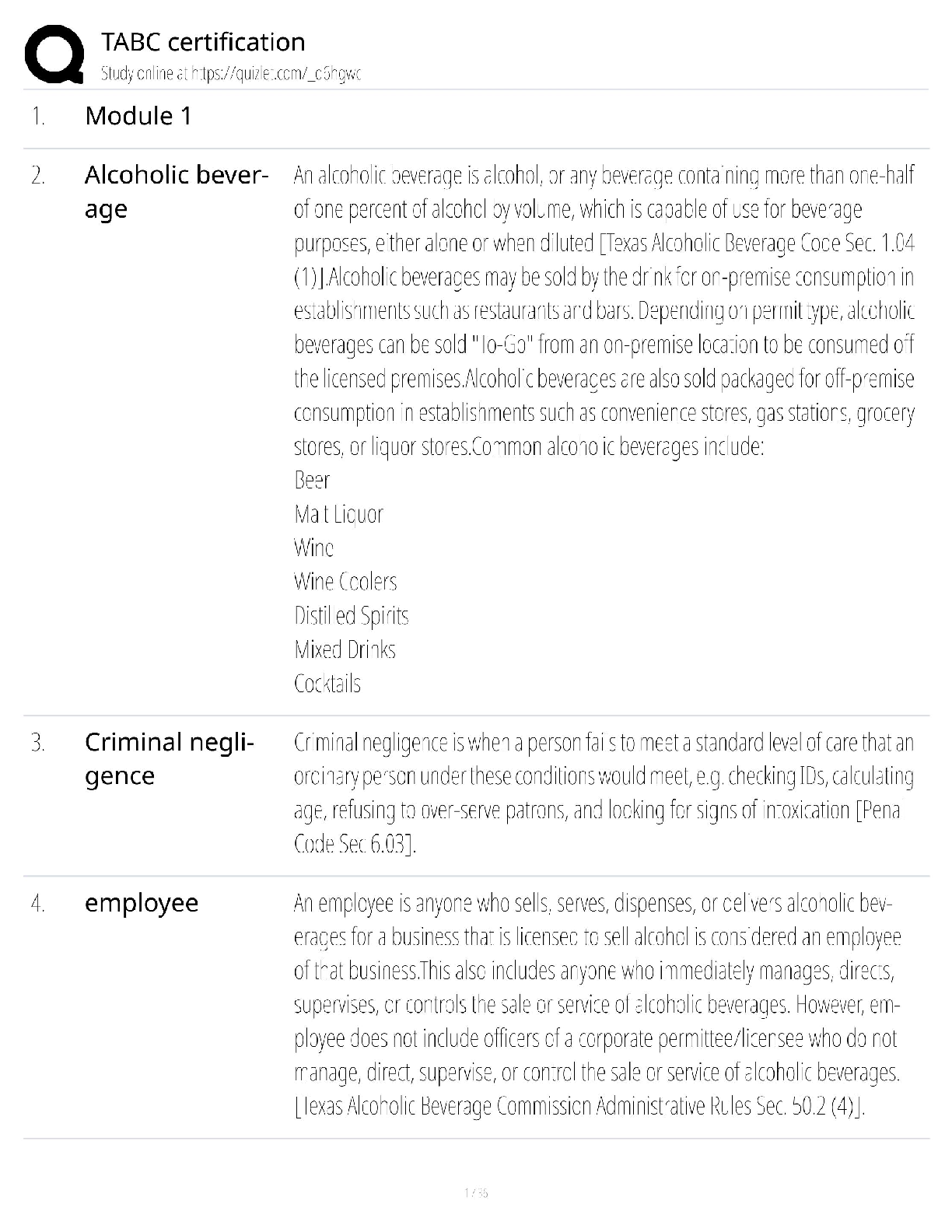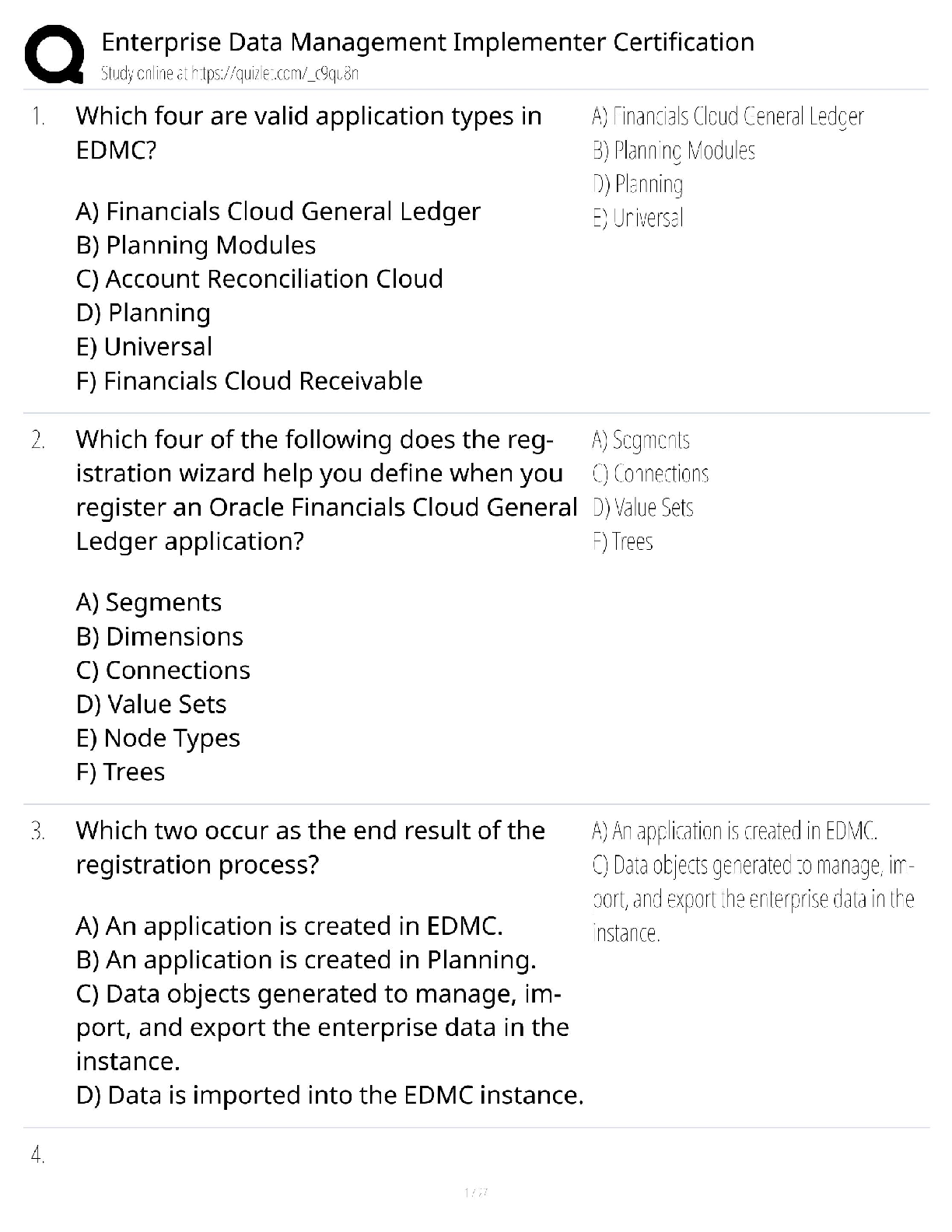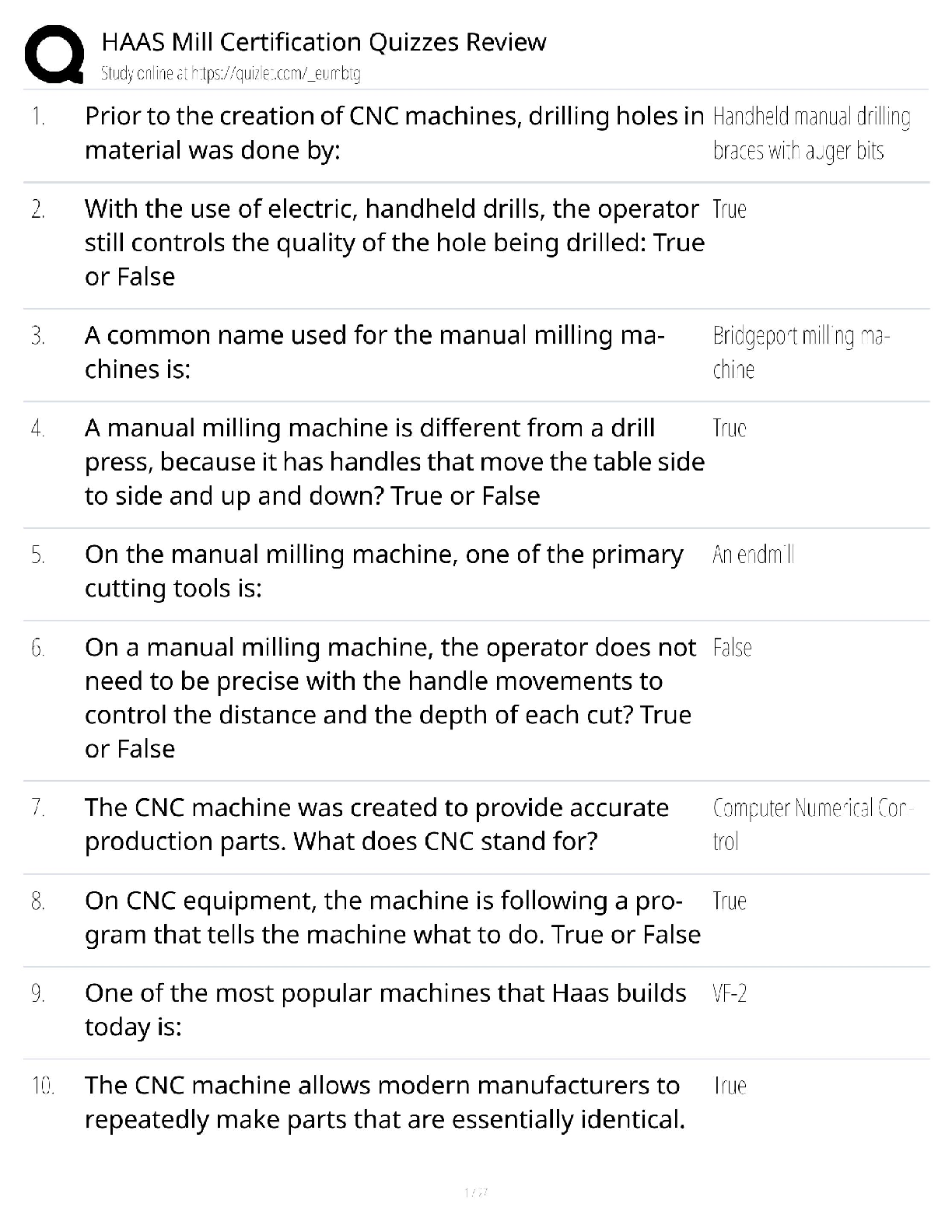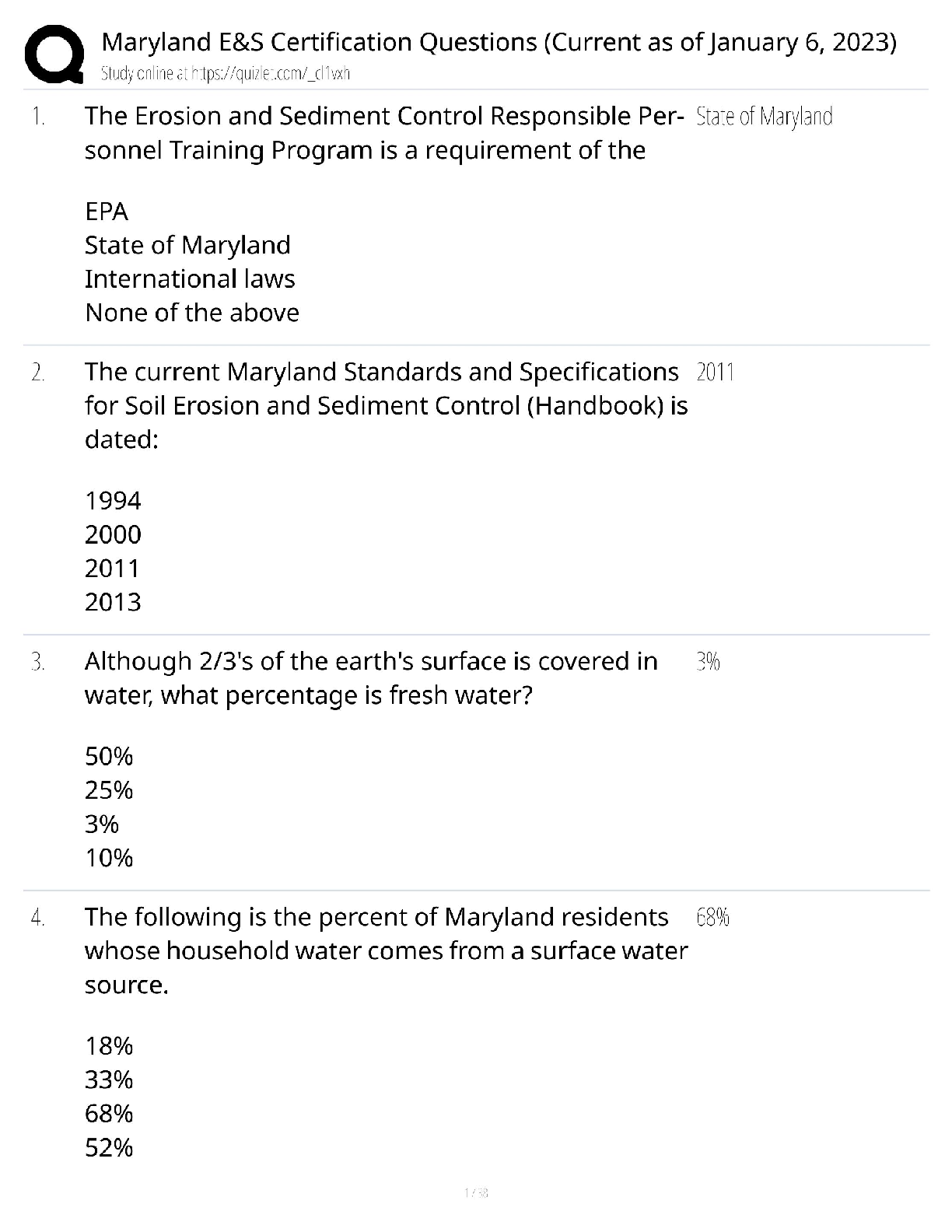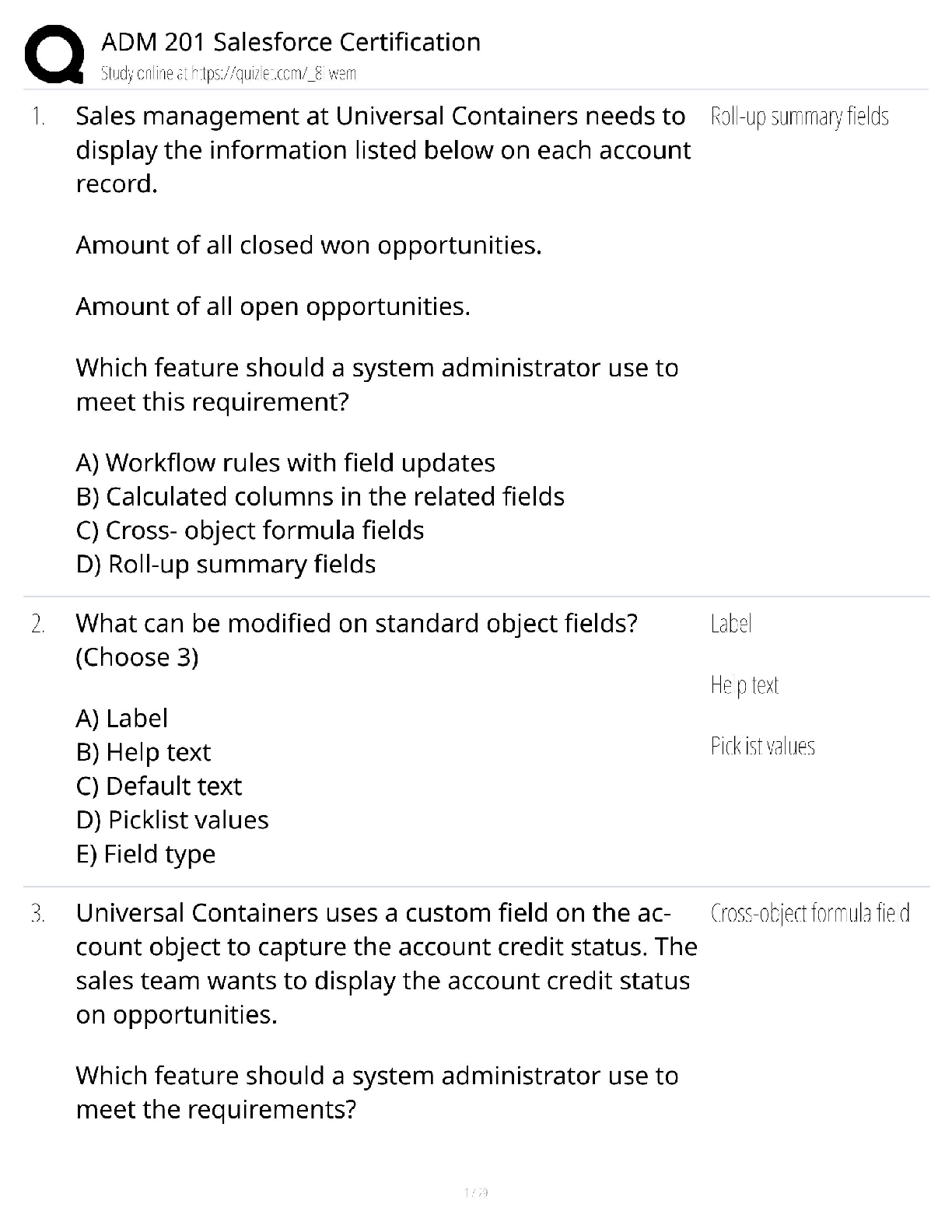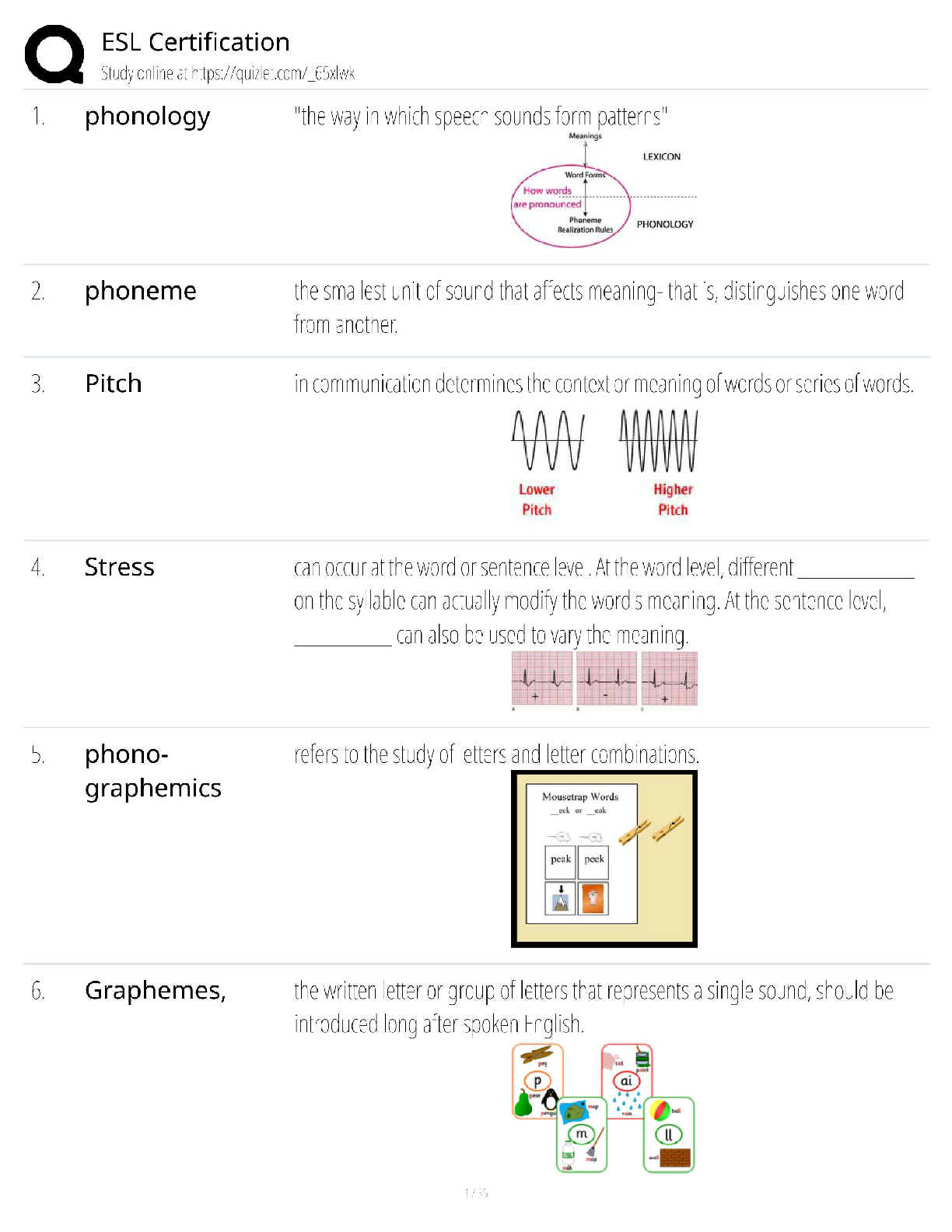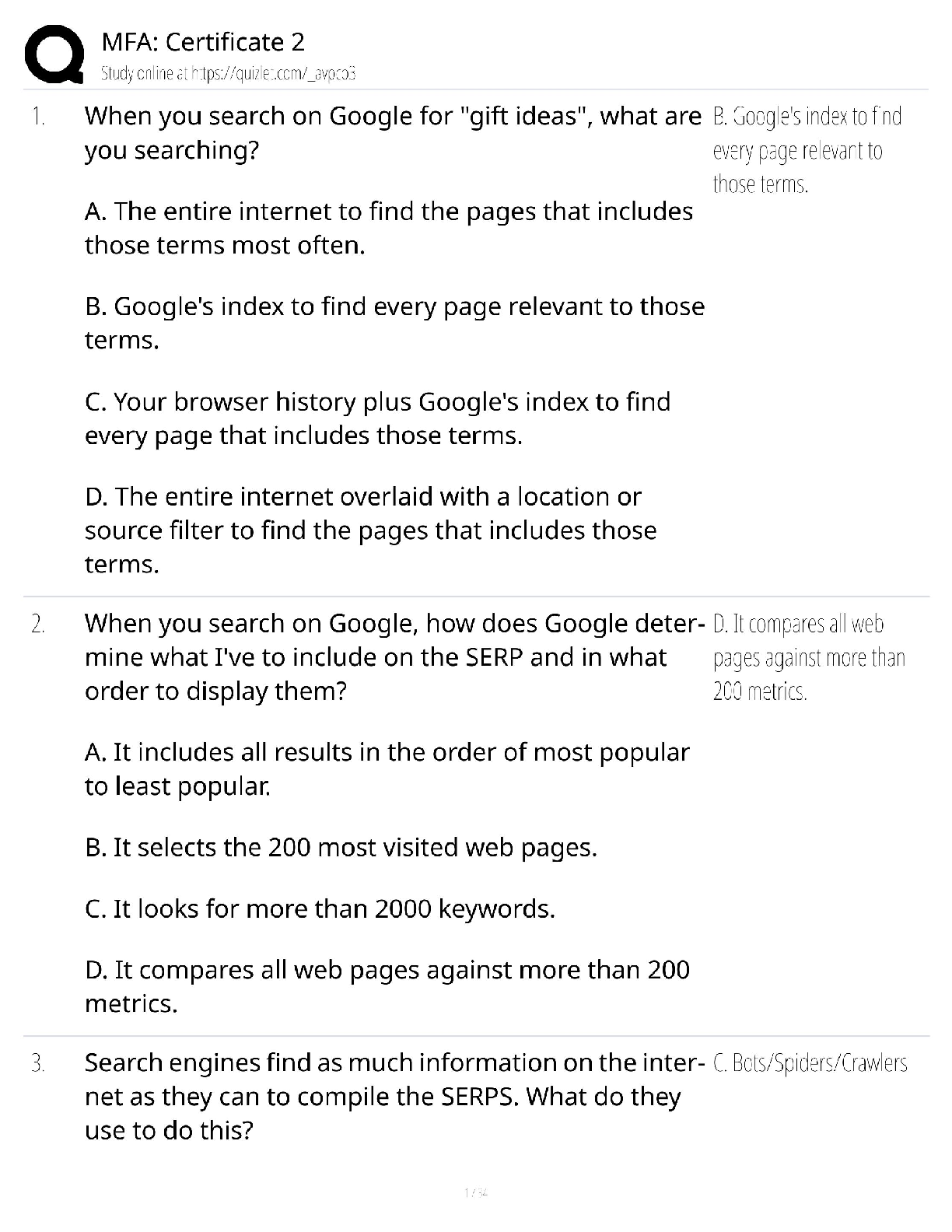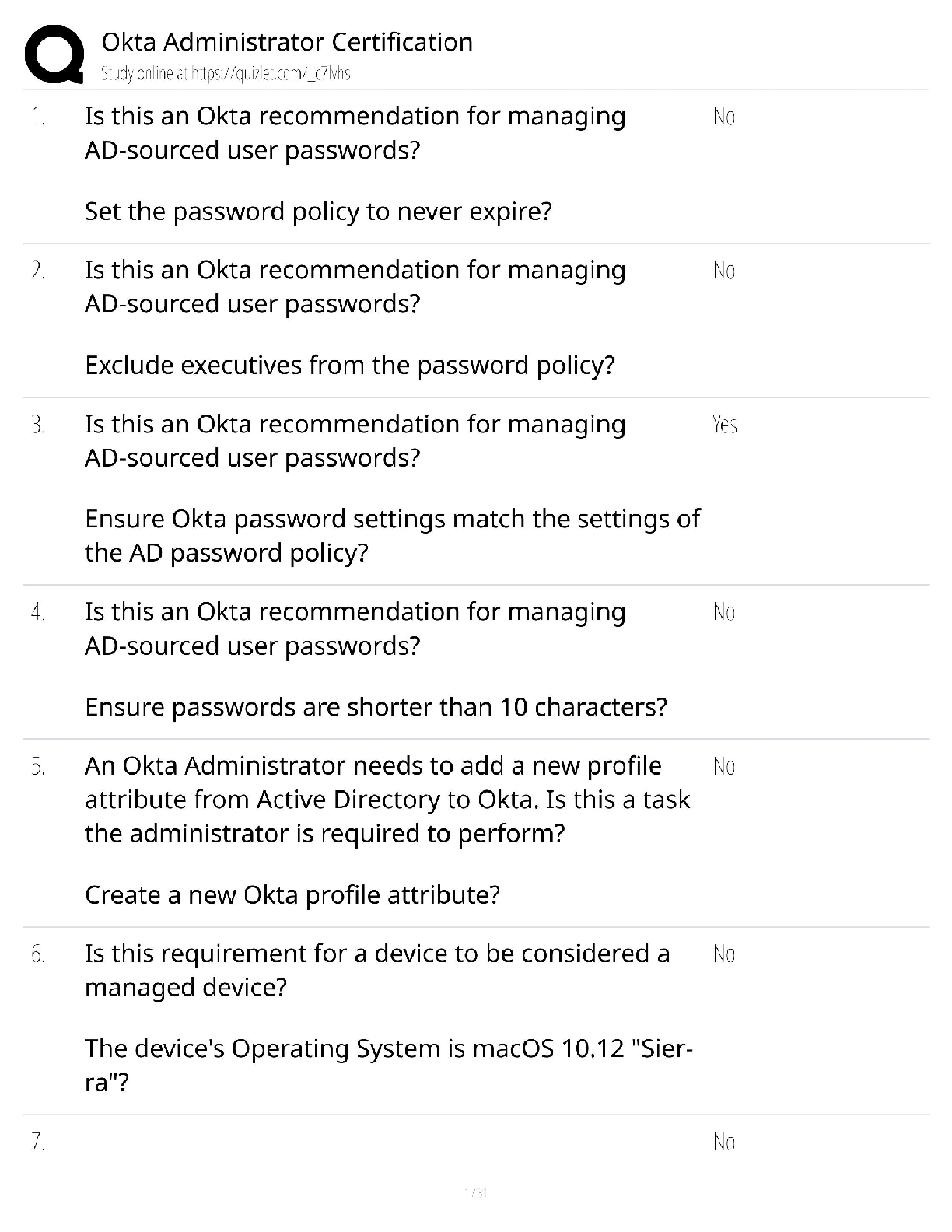Surgery > QUESTIONS & ANSWERS > Sterile Processing CBSPD Test Questions and Answers Already Passed. Rated A (All)
Sterile Processing CBSPD Test Questions and Answers Already Passed. Rated A
Document Content and Description Below
Sterile Processing CBSPD Test Questions and Answers Already Passed Decontamination Area ✔✔Where soiled items are received and cleaned. *All levels for the same tray should be labeled w/a tag to ... identify the level number and set to which it belongs. Preparation and Packaging Area ✔✔where cleaned items are inspected, assembled, and packaged. Sterilization Area ✔✔where terminal sterilization is performed. Sterile Storage Area ✔✔where sterile items are stored until needed. Sterile Stores ✔✔where items for patient care from outside manufacturers are stored. Sometimes referred to as Medical Supply Distribution, Central Supply, or similar designation. Case Cart Area ✔✔where sterile supplies (trays and/or sterile items from outside manufacturers) are kept and picked for surgical cases. Dispatch ✔✔where sterile and clean items are dispensed. Loaner Area ✔✔for the receipt and return of instruments borrowed for specialty procedures. Patient Care Equipment Clean-Up Area ✔✔where patient care equipment is cleaned and disinfected. SPD Responsibilities ✔✔providing dependable, reliable services to enhance the quality of patient care. Instruments sets, patient care equipment, and other medical devices must be processed and distributed in an accurate and timely manner so that patient care is not adversely affected.Work Flow ✔✔how the work progresses through the department or processing area. *Dirty to Clean People Flow ✔✔how people move through the department or processing area. *Clean to Dirty Traffic Control ✔✔controlling access to SPD Ethics ✔✔the discipline dealing with what is good and bad and with moral duty and obligation. Ethical Actions ✔✔actions that conform to accepted and professional standards of conduct. Morals ✔✔deal with or relate to principles of right and wrong behavior. Unethical Professional Conduct ✔✔failure to conform to moral standards or policies. Professional Ethics ✔✔principles of conduct governing an individual or group. American Medical Association (AMA) ✔✔the most important organization related to healthcare ethics. Regulation ✔✔a principle, rule, or law designed to control or govern behavior. Agencies that issue regulations ✔✔EPA, FDA, OSHA and State health departments Standard ✔✔an established norm determined by opinion, authority, research and/or theory. Recommended Practices ✔✔statements of sound principles of practice based on scientific data and opinions of experts.Agencies that set standards ✔✔AAMI, CDC Examples of recommended practices ✔✔documents developed by IAHCSMM, SGNA, AORN Environmental Protection Agency (EPA) ✔✔Registers and regulates environmental disinfectants, controls emissions into the air and water, regulates the manufacture and sale of EO gas Food and Drug Administration (FDA) ✔✔regulates all medical devices. MedWatch (recalls); approves reprocessing of single use devices; require IFU (instructions for use) Function of CS/SPD ✔✔receives, cleans, decontaminates, assembles, inspects, disinfects, sterilizes reusable medical and surgical devices Sterile processing is A.K.A ✔✔Central Material Service, Sterile Processing Service, Central Service, Sterile Processing Department Two groups that certify ✔✔CBSPD (Cerification board for sterile processing and distribution, IAHCSMM (International association of healthcare central service material management) Chain of command ✔✔chief operating officer, VP nursing, sterile processing manager, SPD lead tech, SPD processing tech, SPD inventory tech, SPD case cart tech Compliance w/a regulation is ✔✔mandatory/required by law Confidentiality ✔✔HIPAA (Health insurance portability and accountability act) the manufacturer performs ________ for a product, the facility end user performs _______. ✔✔validation; verificationOccupational Safety Health Administration (OSHA) ✔✔protects workers; OSHA standards are required by law; sets occupational exposure limits for all chemicals in the workplace under mSDS (material safety data sheet); "right to know"; Emergency eyewash stations Responsible for regulating EO gas ✔✔OSHA, EPA Ergonomics ✔✔OSHA; fitting the job to the worker, prevent injuries before they occur Emergency eyewash stations ✔✔available within 10 seconds/30 meters of chemicals; hands-free; test regularly and document, 0 4 gallons of water. Government Agencies ✔✔EPA, FDA, OSHA NFPA ✔✔National Fire Protection Association Center for Disease Control and prevention (CDC) ✔✔voluntary; promotes health by preventing and controlling disease; publishes recommendations and guidelines; hand hygiene (15 second minimum); NO artificial nails; classifies medical devices according to Spaulding Spaulding Classification ✔✔Critical (exposed to sterile areas of the body; must be sterile); SemiCritical (touches mucous membranes; recommended sterile or high level disinfected); Non Critical (touch the skin; can be cleaned or disinfected; less than high level disinfection) NFPA Blue Diamond ✔✔health hazard NFPA Red Diamond ✔✔flammability NFPA Yellow Diamond ✔✔instabilityNFPA White Diamond ✔✔special hazard information The Joint Commission (TJC) formally (Joint Commission on Accreditation of Healthcare Organizations (JCAHO)) ✔✔voluntary; establishes accrediting standards and conducts onsite inspections; annual competency testing Association for the Advancement of Medical Instrumentation (AAMI) ✔✔voluntary; sets standards for CS/SPD Association of peri-Operative Registered Nurses (AORN) ✔✔voluntary; develops nationally recognized standards, recommended practices and guidelines for peri-operative setting Association for Professionals in Infection Control (APIC) ✔✔voluntary; international organization dedicated to prvention and control of infections Society of Gastroenterology Nurses and Associates (SGNA) ✔✔voluntary; established standards for effective processing of flexible endoscopes Department Of Transportation (DOT) ✔✔enforces laws relating to transportation of medical wastes American National Standards Institute (ANSI) ✔✔voluntary; proposes standards to include enhancing the global competitiveness and quality of life World Health Order (WHO) ✔✔voluntary; furthers international cooperation in improving health conditions National Institute for Occupational Safety and Health (NIOSH) ✔✔division of CDC; oversees airborne control/respiration masksFire Safety ✔✔ALL equipment (including personal) should be safety checked by Biomedical Engineering Dept. and approval label attached before use Class A Fire Extinguisher ✔✔ordinary combustibles Class B Fire Extinguisher ✔✔flammable and combustible liquids Class C Fire Extinguisher ✔✔electrical equipment Class D Fire Extinguisher ✔✔combustible metals Class K Fire Extinguisher ✔✔oils/fats in cooking appliances R>A>C>E (fire safety) ✔✔Remove/Rescue; Alarm; Contain/Confine; Extinguish P>A>S>S (operation of fire extinguisher) ✔✔Pull the pin; Aim the nozzle; Squeeze the handle; Sweep the stream over base of fire Personal Protective Equipment (PPE) ✔✔MUST be worn to protect from blood and bodily fluid Sharps ✔✔instruments/devices with points/blades disposable sharps must be disposed in ✔✔rigid biohazard container warm up jackets ✔✔worn to prevent hair and bacterial shedding from bare arms Quality Assurance (QA) ✔✔collection of data and identification of issues Training ✔✔should be standardizedTAH ✔✔Total Abdominal Hysterectomy THA ✔✔Total Hip Arthroplasty Lap Appy ✔✔Laparoscopic Appendectomy Lap Chole ✔✔Laparoscopic Cholecystectomy ORIF ✔✔Open Reduction Internal Fixation CABG ✔✔Coronary Artery Bypass Graft BKA ✔✔Below the Knee Amputation TSA ✔✔Total Shoulder Arthroplasty Anatomy ✔✔structure, form and organization of body parts superior ✔✔toward the head inferior ✔✔toward the feet distal ✔✔toward end of limb proximal ✔✔top of limb; opposite distal superficial ✔✔toward surface of skin; opposite deepmedial ✔✔toward center of body; opposite lateral Physiology ✔✔functions of body parts Cell ✔✔fundamental unit of life; smallest and most numerous structure of body; performs all processes needed for life Cells require ✔✔water; food; oxygen; heat; pressure; Do NOT require cold Cellular>Tissue>Organ>System ✔✔levels of organization of body Homeostasis ✔✔state of equilibrium; conditions within cells must remain stable Nucleus ✔✔brain of cell; where DNA is found Cell structure ✔✔Nucleus>Cell Wall>Cell Membrane>Cytoplasm>Cilla and Flagella Major body systems ✔✔11; Skeletal, Muscular, Nervous, Endocrine, Circulatory; Cardiac, Lymphatic, Digestive, Integumentary, Respiratory, Reproductive, Urinary Skeletal system ✔✔framework for body; protects internal organs grow and develop in bone marrow ✔✔red and white blood cells adult body consist of _____ bones ✔✔206; plus ligaments and cartilage Flat bones ✔✔protective shells (ribs) Long bones ✔✔raise and lower (humerus and femur)Short bones ✔✔bridges (metacarpals) Irregular bones ✔✔don't fit any specific category (pelvis) bony and cartilaginous parts that support and protect head, neck and trunk ✔✔Axial skeleton Axial skeleton ✔✔skull>hyoid bone>vertebral column>thoracic cage skull ✔✔cranium and facial bones hyoid bone ✔✔located in neck; supports tongue and swallowing; only bone NOT articulated w/another vertebral column ✔✔vertebrae separated by discs; lumbar, thoracic and cervical spine PLIF ✔✔Posterior Lumbar Interbody Fusion Thoracic cage ✔✔sternum and 12 pairs of ribs; protect organs of chest and upper abdomen Making an opening into thoracic cavity to give surgeons access to lung and heart ✔✔Thoracotomy Appendicular skeleton ✔✔Appendages Pectoral girdle ✔✔scapula and clavicle connect bones of arms and aids movemnet Upper limb bones ✔✔humerus, radius, ulna, carpals, metacarpals and phalangesCarpal Tunnel Repair ✔✔removing tissue displaced bone in wrist area to release pressure on median nerve Lower limb bones ✔✔femur, tibia, fibula, patella, tarsals humerus, radius, ulna ✔✔connect at elbow joint carpals, metacarpals, phalanges ✔✔form wrist and hand femur, tibia, fibula ✔✔connect at knee joint patella ✔✔knee bone tarsals ✔✔ankle; metatarsals and phalanges form ankle and foot Joints ✔✔junctions between bones; articulation total hip and knee sets; osteotomes; screw sets ✔✔instruments used for skeletal system skeletal muscle ✔✔responds to stimulation by contracting and relaxing; voluntary; striated; *attached to bone by a tendon smooth muscle ✔✔involuntary movement; slower to contract and relax; common throughout body systems (e.g. digestive tract) Types of muscle tissue ✔✔Cardiac; Smooth; Skeletal cardiac muscle ✔✔makes up heart; contracts automatically; involuntary and rhythmicalACL ✔✔Anterior Cruciate Ligament a repair to the muscles and ligaments of the shoulder joint ✔✔Rotator Cuff Repair Integumentary system ✔✔skin, hair, glands and nails largest organ OF the body ✔✔skin epidermis; dermis; hypodermis ✔✔layers of integument epidermis ✔✔superficial protective layer dermis ✔✔deeper than epidermis; *contains nerves and blood supply hypodermis (subcutaneous) ✔✔deepest layer of skin circulatory system ✔✔pumps blood (tissue) throughout the entire body and removes waste products transportation, regulation, protection ✔✔3 main functions of the circulatory system heart ✔✔pumps more than 10 gallons of blood a minute through arteries and veins; has 4 chambers atria ✔✔upper chambers; receive blood back from veins ventricles ✔✔lower chambers; force blood out of heart into arteries separated by septum ✔✔right and left chambersseparated by mitral (bicuspid) and tricuspid valves ✔✔atria and ventricles when veins vs. arteries are reversed in the concept of blood flow ✔✔pulmonary; bluish color of vein indicate blood needs oxygen sternal saws, open heart instruments, coronary dilators ✔✔instruments used for circulatory system main function is to supply oxygen to the body and remove carbon dioxide from the body; *the area where homeostasis (regulation) of pH occurs in the body ✔✔Respiratory system upper respiratory system ✔✔nose, nasal cavity, pharynx, sinuses and larynx lower respiratory system ✔✔trachea, bronchial tree, lungs breathing ✔✔inhalation and expiration; exchange of air between atmosphere and alveoli of lungs instruments used for respiratory system ✔✔bronchoscopes; tracheostomy sets digestion and absorption ✔✔main functions of digestive system (GI tract) tonsillectomy ✔✔removing lymph tissue in the pharynx (throat) oral cavity ✔✔ingest food, mix w/ saliva and swallow pharynx ✔✔receives food and transports to esophagus esophagus ✔✔transports food to stomach by peristalsis stomach ✔✔receives food from esophagus; mixes with gastric juices; moves chyme to duodenumsmall intestine ✔✔*longest part of GI tract; receives chyme; liver and pancreatic secretions breaks down chyme; absorbs nutrients and transports waste to large intestine large intestine ✔✔ascending colon; transverse colon; descending colon; sigmoid colon; rectum; forms, stores and expels feces through anus Accessory digestive organs ✔✔teeth, tongue, salivary glands, liver, pancreas teeth ✔✔accessories of mechanical chewing tongue ✔✔moves food around; assist w/swallowing salivary glands ✔✔produce saliva to cleanse teeth and dissolve food chemicals; mucous used to lubricate pharynx parotidectomy ✔✔removing a salivary gland because of a tumor formation liver ✔✔*largest INTERNAL organ; produces and secretes digestive enzyme bile pancreas ✔✔secretes pancreatic juice for digestion; regulates blood sugar instruments used for digestive system ✔✔laparoscopes, sigmoidoscope, colonoscope, laparotomy set central nervous system ✔✔brain and spinal cord peripheral nervous system ✔✔nerves connecting brain and spinal cord to the other outside parts of the bodysomatic system ✔✔peripheral nerves communicate w/ skin and skeletal muscles autonomic system ✔✔nerves communicate w/visceral organs cover spinal cord ✔✔vertebrae covers brain ✔✔skull protect membrane between bones and soft tissue of central nervous system ✔✔meninges carry messages from brain to organs and muscles ✔✔motor nerves carry information to the brain ✔✔sensory nerve gather information ✔✔dendrites ONE of the largest organs in the body; controls all movement; monitors and maintains all body systems ✔✔brain cerebrum ✔✔*center of consciousness; largest part of brain cerebellum ✔✔maintains balance brain stem ✔✔essential functions controlled 3 parts of brain ✔✔cerebrum, cerebellum, brain stemspinal cord ✔✔conducts nerve impulses; center for spinal reflexes; provides two way communication between brain and body major divisions of nervous system ✔✔autonomic/involuntary nervous system; voluntary nervous system nervous system composed of two major parts ✔✔central nervous system (brain an spinal cord); peripheral nervous system (nerves that connect brain and spinal cord to other parts of body) autonomic/involuntary nervous system ✔✔conducts impulses to smooth muscle, cardiac muscle and glands; controls heart rate and breathing voluntary nervous system ✔✔sensation; mental function; skeletal muscle contractions instruments used for the nervous system ✔✔craniotomy sets; cervical fusion discs; laminectomy sets craniotomy ✔✔making an opening into the skull to access the brain sensory organs ✔✔extensions of the nervous system that allow perception of environment sense of smell ✔✔olfactory septoplasty ✔✔straightening or removing cartilage and/or bone in the nose when the nasal septum is deformed, injured or fractured sense of taste ✔✔gustatoryeyebrow, facial muscles, eyelids, eyelashes, conjunctiva and tear ducts ✔✔associated structures of eye eyeball ✔✔fibrous and vascular tunics, retina; sclera; cornea;iris; pupil; retina sense of sight ✔✔eyes refract and focus incoming light waves onto photoreceptors in back of eye organ of hearing ✔✔ear ear ✔✔plays role in equilibrium and balance; consist of the smallest bones of the body tympanoplasty ✔✔reconstructing the ear drum so sound waves can be sent to the middle and inner ear ear consist of ✔✔tympanic cavity and membrane; malleus, incus, and stapes; eustachian tube connects middle ear to throat; cochlea (organ of corti) myringotomy set(ear); cataract set(eye); corneal transplant set(eye) ✔✔instruments used for sensory organs ductless glands; secretes hormones ✔✔endocrine system pituitary, pineal, thyroid, parathyroids, adrenal, pancreas, thymus ✔✔glands of endocrine system master gland; located in brain; coordinates all activities of endocrine system ✔✔pituitary gland thyroidectomy set ✔✔instruments used for endocrine systemregulates pH and volume of body fluids; controls red blood cell production and blood pressure; removes salts and nitrogenous waste from body; helps to maintain normal concentration of water and electrolytes ✔✔urinary system organs of the urinary system ✔✔kidneys, ureters, urinary bladder, urethra kidneys ✔✔eliminates wastes and helps maintain water and chemical balance ureters ✔✔removal of urine from kidneys to bladder urinary bladder ✔✔storage sac for urine urethra ✔✔brings urine from bladder to outside the body nephrectomy ✔✔removal of kidney cystoscopes; ureteroscopes ✔✔instruments used in viewing urinary system testes, seminal vesicles, prostate gland, bulbourethral glands ✔✔male reproductive organs testes ✔✔sperm cells and male sex hormones formed orchiectomy ✔✔removing a testicle seminal vesicles ✔✔secrete fluid as a medium for sperm prostate gland ✔✔secretions assist sperm mobilitybulbourethral glands ✔✔secrete substance to coat lining of urethra, neutralize pH of urine and lubricate penis in preparation for coitus vagina, fallopian tubes, uterus, mammary glands ✔✔female reproductive organs vagina ✔✔receives penis and is birth canal fallopian tubes ✔✔transports egg to uterus uterus ✔✔environment for implantation of egg and development of fetus mammary glands ✔✔produce milk for nourishment of child after birth BSO ✔✔Bilateral SalpingoOopherectomy Bilateral SalpingoOopherectomy ✔✔removing both fallopian tubes and ovaries instruments used for the reproductive system ✔✔laparotomy sets; vaginal delivery sets; vasectomy set microbiology ✔✔branch of biology; deals with microorganisms and their effects on other living organisms minute living things too small to be seen with the naked eye ✔✔microorganisms etiology ✔✔branch of science; studies the cause of and origins of disease/abnormal conditions state of being soiled or infected by contact with infectious organisms or other material ✔✔contaminationinfection ✔✔invasion of body tissue by microorganisms which multiply and produce a reaction host ✔✔animal, plant or human that supports the growth of microorganisms microbe ✔✔organisms of microscopic/submicroscopic size; generally include viruses, rickettsiae, bacteria, algae, yeasts and molds chain of infection ✔✔six steps; causative agent, reservoir of the agent, portal of exit, mode of transmission, portal of entry, susceptible host causative agent ✔✔the microorganism that causes an infectious disease reservoir of the agent ✔✔the place where an infectious agent (microorganism) can survive portal of exit ✔✔the path by which an infectious agent leaves the reservoir mode of transmission ✔✔the method of transfer of an infectious agent from the reservoir to a susceptible host portal of entry ✔✔the path used by an infectious agent to enter a susceptible host susceptible host ✔✔a person or animal that lacks the ability to resist infection by infectious agent bacteria, viruses, fungi, protozoa and microscopic algae ✔✔microorganisms include some but not all _______________ are harmful to your body ✔✔microorganisms few microorganisms are__________ ✔✔pathogenic (disease producing)pathogenic ✔✔disease producing mesophiles ✔✔often pathogenic to humans because they grow best at body temperature; 68-113 degrees F psychrophiles ✔✔like cold temperature; 59-68 degrees F thermophiles ✔✔like warm temperature; 122-158 degrees F bacteria measured in ✔✔microns 1 micron= ✔✔1/25 thousandths of an inch gram stain; Ziehl-Neilson stain ✔✔helps identify different types of bacteria via color change gram negative stain ✔✔red/pink gram positive stain ✔✔purple/blue the functional center of a cell that governs activity and heredity ✔✔nucleus cocci ✔✔round/spherical shaped cocci bacillus ✔✔rod shaped bacilli sprilillum ✔✔spiral and corkscrew flagella ✔✔thread like tails; help bacteria move through liquidsbinary fission ✔✔bacterial reproductive process that takes place when a mother cell divides into two daughter cells requirements for bacteria to survive ✔✔warmth, food, and water aerobic bacteria ✔✔aerobes; require free oxygen to grow anaerobic ✔✔do NOT require oxygen to grow angstrom= ✔✔measure visible light gram positive organisms (rods/bacilli) ✔✔ability to slow down metabolism and become dormant when environment threatened; form (endo)spores spores ✔✔microorganisms capable of forming thick (shell-like) wall around themselves to survive in adverse conditions absence of ALL microbial life (including spores) is accomplished via ✔✔sterilization in order to test the effectiveness of some sterilization cycles ______________ are within a biological indicator vial ✔✔spores geobacillus stearothermophilus; bacillus atrophaeus ✔✔2 most common biological spores involved in SPD sterilization used to test for: regular steam sterilization(autoclave), sterrad, V-pro & ozone ✔✔geobacillus stearothermophilusused to test for: dry heat sterilization and EtO ✔✔bacillus atrophaeus mycobacterium ✔✔aerobic, non-spore forming, non-moving, rod-shaped organisms; usually found in soil cause of tuberculosis ✔✔mycobacterium tuberculosis responsible for leprosy ✔✔mycobacterium leprae staphylococci ✔✔gram positive cocci; common cause of nosocomial infections; MRSA pseudomonas ✔✔gram negative organism; responsible for infections in lower respiratory tract, burns, urinary tract, ear and eye escherichia coli (E.coli) ✔✔gram negative organism; frequent cause of infections of the bloodstream, urinary tract, GI tract salmonella ✔✔gram negative organism; sources include eggs, poultry and dairy spirochetes ✔✔spiral-like shape; found in water, sewage, soil and decaying organic matter; reason water in SPS decontamination needs to be looked at being treated (filtered, softened, distilled, sterile, etc.) viruses ✔✔one of a group of minute infectious agents that grow ONLY in living tissues/cells; require living host to multiply; not composed of cells protozoa ✔✔single celled (animal-like) microorganisms fungi ✔✔plant-like; can cause serious illness/death in immunocrompromised peopleprions ✔✔virus-like; cause variety of neurodegenerative diseases of humans and animals; have affinity for eye, brain and spinal cord tissues; *VERY difficult to kill by usual sterilization methods (considering HCF's willingness to reprocess- extended exposure time in steam) TSE ✔✔Transmissible Spongiform Encephalopathies BSE ✔✔Bovine Spongiform Encephalopathy; mad cow disease Creutzfeldt-Jakob Disease (CJD) ✔✔caused by prions; not a virus major cause of healthcare acquired infections ✔✔staph aureus MRSA ✔✔usually transmitted by healthcare workers due to poor/infrequent handwashing, or w/ pateients who have been on antibiotic therapy for a long time; Methicillin Resistant Staph Aureus Salmonella, M.tuberculosis, E.coli, streptococcus ✔✔Multi-Drug Resistant Organisms BMT ✔✔Bilateral MyringoTomy VRE ✔✔Vancomycin Resistant Enterococcus Myringotomy ✔✔making incision into tympanic membrane (eardrum) to permit fluid to drain and placing small tubes in membrane to permit continuous drainage Cholecystectomy ✔✔removing of gallbladder Coronary Artery Bypass Graft ✔✔removing a vein from the lower limb to bypass a blocked coronary artery of the heart [Show More]
Last updated: 3 years ago
Preview 1 out of 157 pages

Buy this document to get the full access instantly
Instant Download Access after purchase
Buy NowInstant download
We Accept:

Also available in bundle (1)
Click Below to Access Bundle(s)
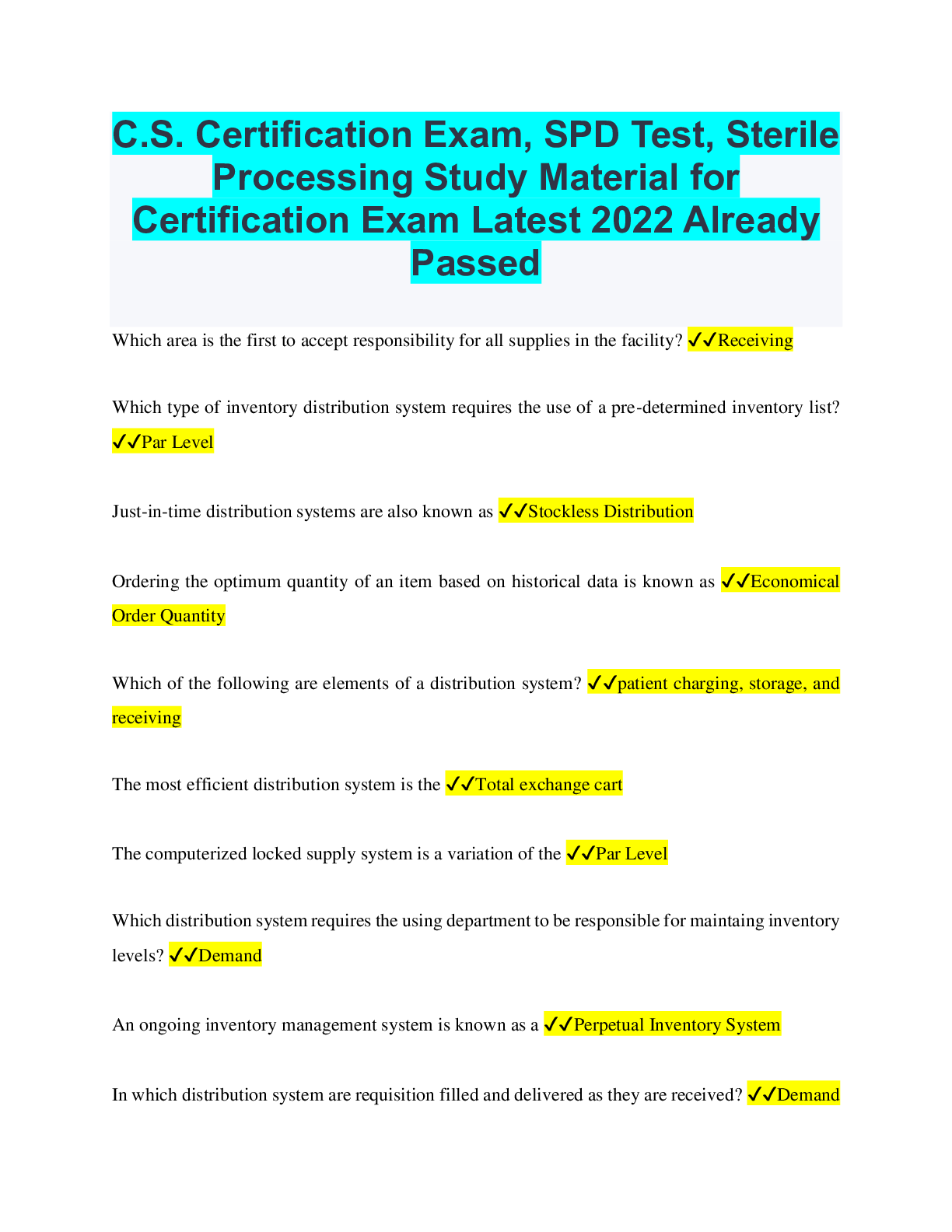
C.S. Certification Exam, SPD Test, Sterile Processing Bundle. Complete Questions with accurate answers,
C.S. Certification Exam, SPD Test, Sterile Processing Bundle. Complete Questions with accurate answers, All ypu need to score A
By bundleHub Solution guider 3 years ago
$45.5
32
Reviews( 0 )
$8.00
Can't find what you want? Try our AI powered Search
Document information
Connected school, study & course
About the document
Uploaded On
Sep 27, 2022
Number of pages
157
Written in
All
Seller

Reviews Received
Additional information
This document has been written for:
Uploaded
Sep 27, 2022
Downloads
0
Views
150












